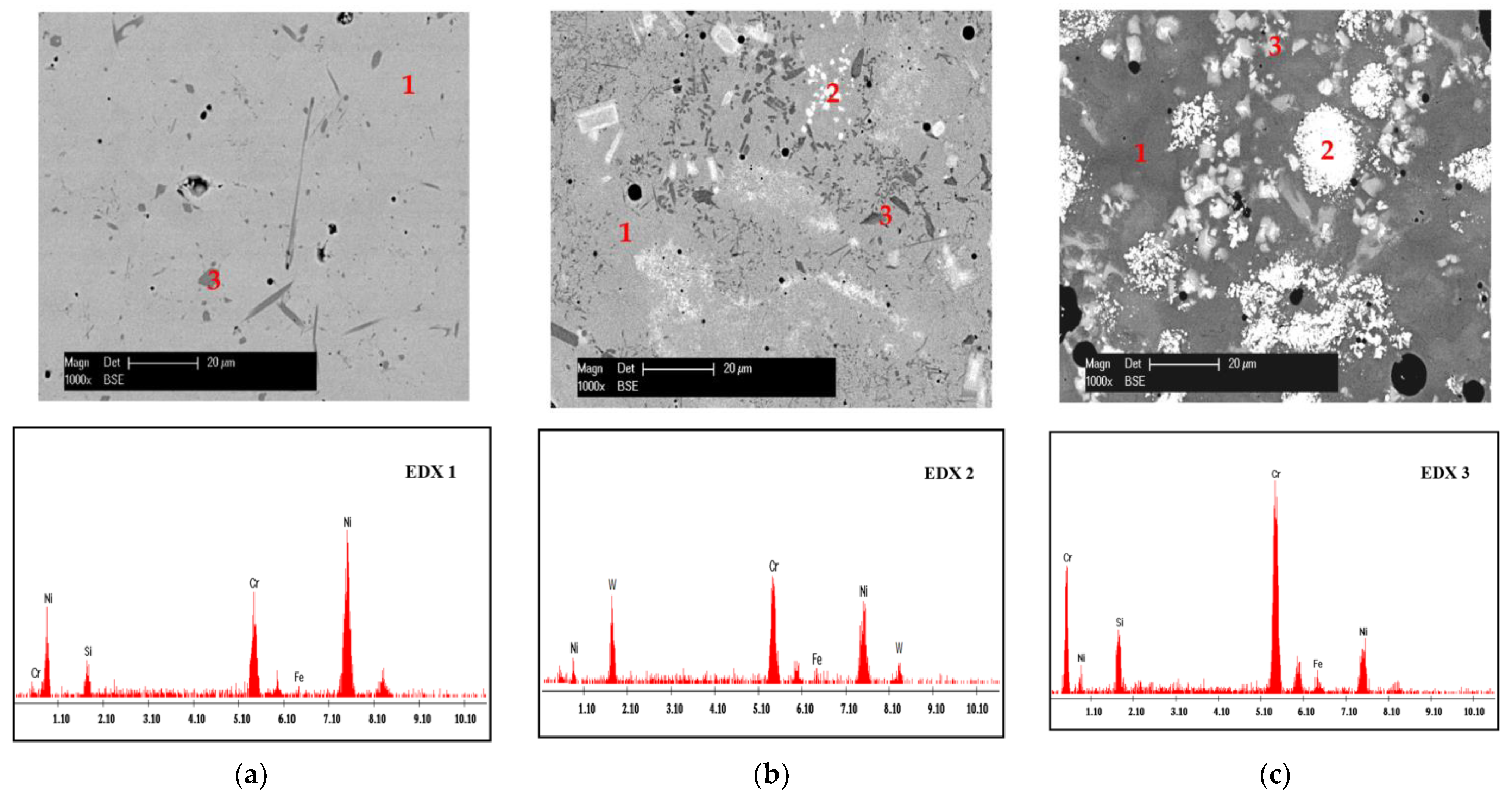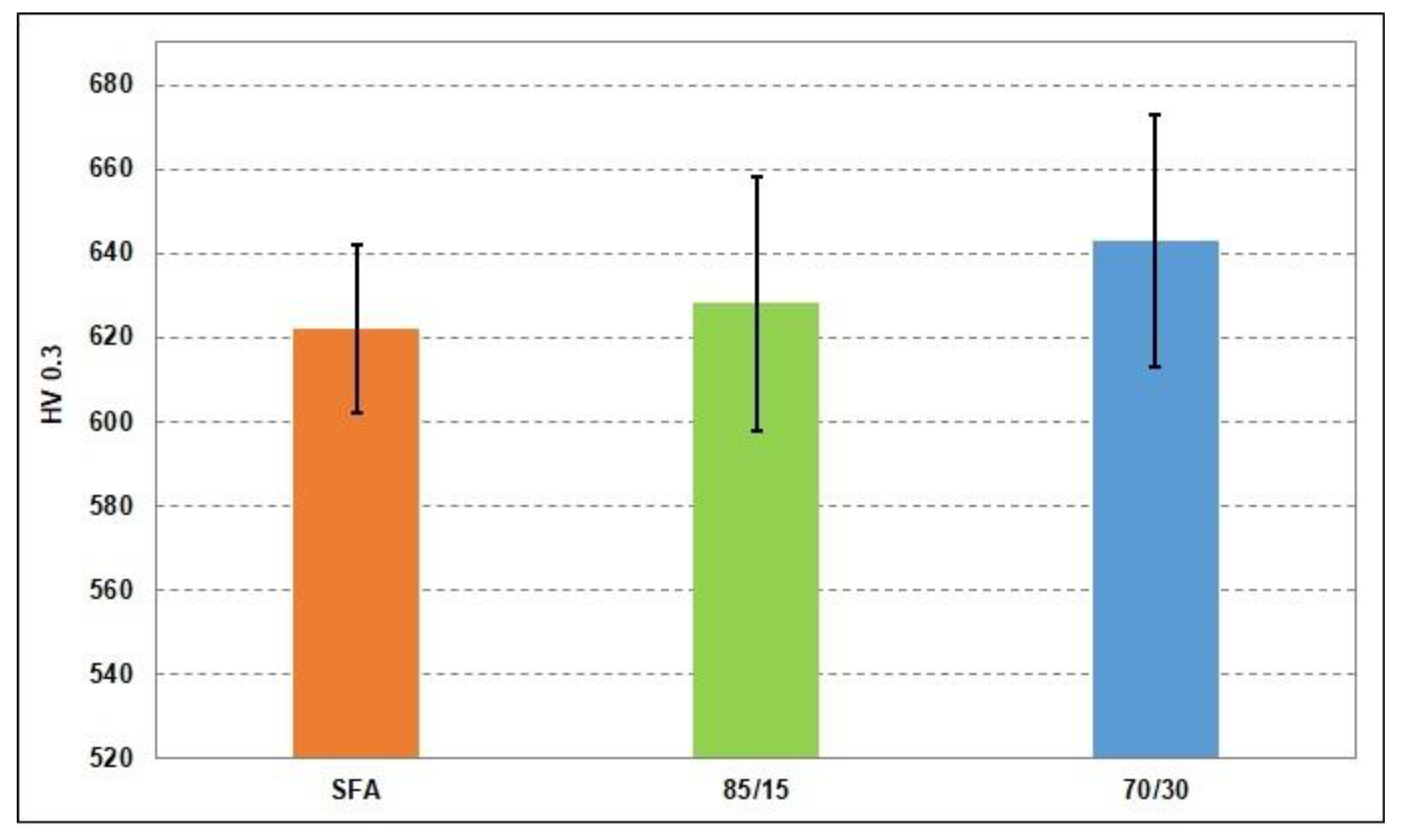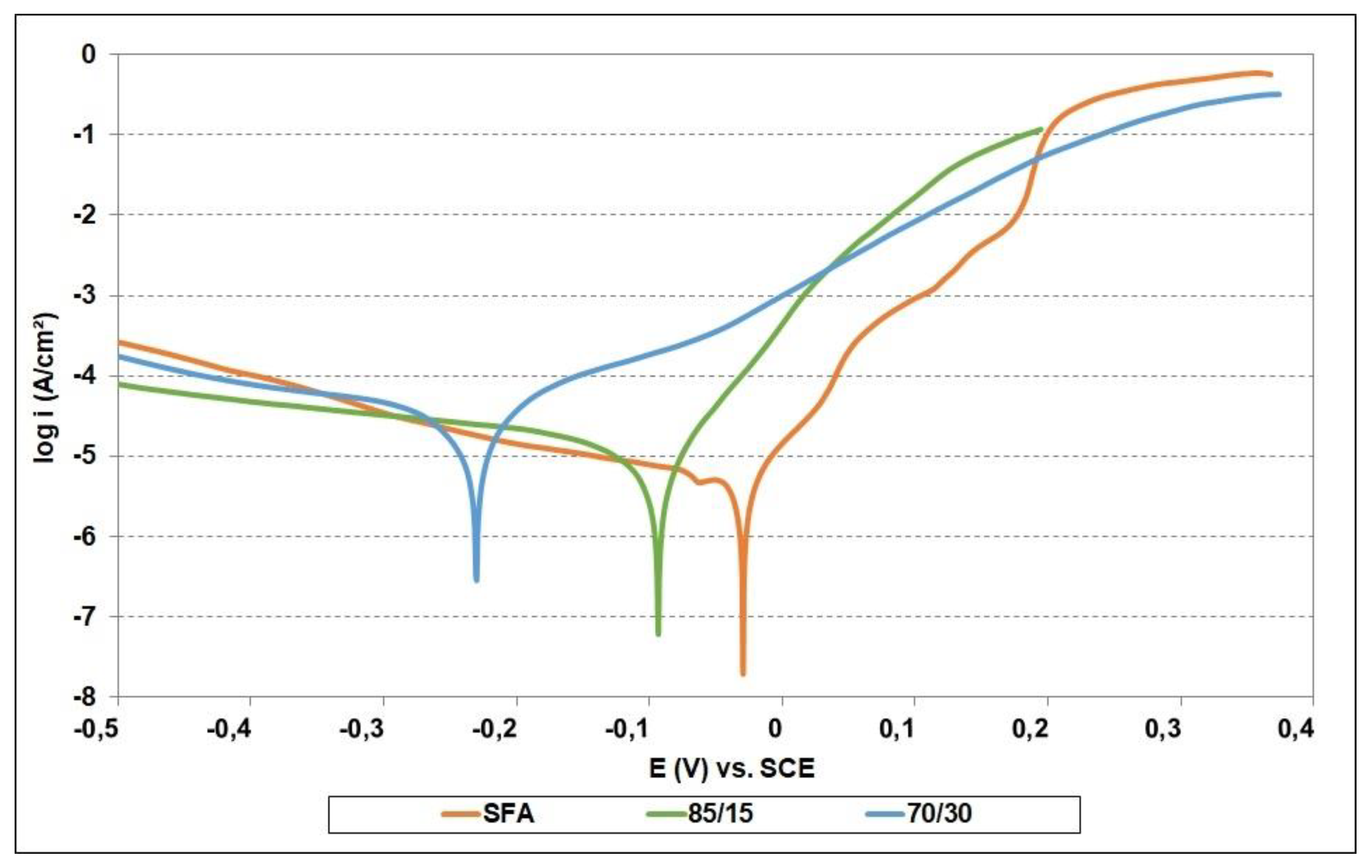Investigations of Cavitation Erosion and Corrosion Behavior of Flame-Sprayed NiCrBSi/WC-12Co Composite Coatings
Abstract
1. Introduction
2. Materials and Methods
3. Results
3.1. Microstructural Characterization of the Coatings
3.2. Microhardness Tests
3.3. Corrosion Behavior
3.4. Cavitation Erosion Behavior
4. Conclusions
Author Contributions
Funding
Institutional Review Board Statement
Informed Consent Statement
Data Availability Statement
Acknowledgments
Conflicts of Interest
References
- Jindal, C.; Sidhu, B.S.; Kumar, P. Role of surface treatment for enhancing resistance to degradation: An outline. Mater. Today Proc. 2021. [Google Scholar] [CrossRef]
- Govande, A.R.; Chandak, A.; Sunil, B.R.; Dumpala, R. Carbide-based thermal spray coatings: A review on performance characteristics and post-treatment. Int. J. Refract. Met. Hard Mater. 2021, 103, 105772. [Google Scholar] [CrossRef]
- Javed, M.A.; Ang, A.S.M.; Bhadra, C.M.; Piola, R.; Neil, W.C.; Berndt, C.C.; Leigh, M.; Howse, H.; Wade, S.A. Corrosion and mechanical performance of HVOF WC-based coatings with alloyed nickel binder for use in marine hydraulic applications. Surf. Coat. Technol. 2021, 418, 127239. [Google Scholar] [CrossRef]
- Galedari, S.A.; Mahdavi, A.; Azarmi, F.; Huang, Y.; McDonald, A. A Comprehensive Review of Corrosion Resistance of Thermally-Sprayed and Thermally-Diffused Protective Coatings on Steel Structures. J. Therm. Spray Technol. 2019, 28, 645–677. [Google Scholar] [CrossRef]
- Qiao, L.; Wu, Y.; Hong, S.; Long, W.; Cheng, J. Wet abrasive wear behavior of WC-based cermet coatings prepared by HVOF spraying. Ceram. Int. 2020, 47, 1829–1836. [Google Scholar] [CrossRef]
- Marginean, G.; Utu, D. Microstructure refinement and alloying of WC–CoCr coatings by electron beam treatment. Surf. Coat. Technol. 2010, 205, 1985–1989. [Google Scholar] [CrossRef]
- Ciubotariu, C.R.; Secosan, E.; Marginean, G.; Frunzaverde, D.; Campian, V.C. Experimental Study Regarding the Cavitation and Corrosion Resistance of Stellite 6 and Self-Fluxing Remelted Coatings. Stroj. Vestn.-J. Mech. Eng. 2016, 62, 154–162. [Google Scholar] [CrossRef][Green Version]
- Houdková, Š.; Smazalová, E.; Vostřák, M.; Schubert, J. Properties of NiCrBSi coating, as sprayed and remelted by different technologies. Surf. Coat. Technol. 2014, 253, 14–26. [Google Scholar] [CrossRef]
- Kazamer, N.; Muntean, R.; Vălean, P.C.; Pascal, D.T.; Mărginean, G.; Șerban, V.-A. Comparison of Ni-Based Self-Fluxing Remelted Coatings for Wear and Corrosion Applications. Materials 2021, 14, 3293. [Google Scholar] [CrossRef]
- Karimi, M.R.; Salimijazi, H.R.; Golozar, M.A. Effects of remelting processes on porosity of NiCrBSi flame sprayed coatings. Surf. Eng. 2016, 32, 238–243. [Google Scholar] [CrossRef]
- Mishra, T.K.; Kumar, A.; Sinha, S.K. Experimental investigation and study of HVOF sprayed WC-12Co, WC-10Co-4Cr and Cr3C2-25NiCr coating on its sliding wear behavior. Int. J. Refract. Met. Hard Mater. 2021, 94, 105404. [Google Scholar] [CrossRef]
- Liu, J.; Bai, X.; Chen, T.; Yuan, C. Effects of Cobalt Content on the Microstructure, Mechanical Properties and Cavitation Erosion Resistance of HVOF Sprayed Coatings. Coatings 2019, 9, 534. [Google Scholar] [CrossRef]
- Torkashvand, K.; Joshi, S.; Gupta, M. Advances in Thermally Sprayed WC-Based Wear-Resistant Coatings: Co-free Binders, Processing Routes and Tribological Behavior. J. Therm. Spray Technol. 2022, 31, 342–377. [Google Scholar] [CrossRef]
- Bergant, Z.; Batič, B.Š.; Felde, I.; Šturm, R.; Sedlaček, M. Tribological Properties of Solid Solution Strengthened Laser Cladded NiCrBSi/WC-12Co Metal Matrix Composite Coatings. Materials 2022, 15, 342. [Google Scholar] [CrossRef]
- Alam, M.S.; Das, A.K. Advancement in cermet based coating on steel substrate: A review. Mater. Today Proc. 2022, 56, 2214–7853. [Google Scholar] [CrossRef]
- Du, J.; Zhang, J.; Zhang, C. Effect of Heat Treatment on the Cavitation Erosion Performance of WC–12Co Coatings. Coatings 2019, 9, 690. [Google Scholar] [CrossRef]
- Ding, X.; Ke, D.; Yuan, C.; Ding, Z.; Cheng, X. Microstructure and Cavitation Erosion Resistance of HVOF Deposited WC-Co Coatings with Different Sized WC. Coatings 2018, 8, 307. [Google Scholar] [CrossRef]
- Liu, J.; Chen, T.; Yuan, C.; Bai, X. Performance Analysis of Cavitation Erosion Resistance and Corrosion Behavior of HVOF-Sprayed WC-10Co-4Cr, WC-12Co, and Cr3C2-NiCr Coatings. J. Therm. Spray Technol. 2020, 29, 798–810. [Google Scholar] [CrossRef]
- Luiz, L.A.; de Andrade, J.; Pesqueira, C.M.; de Araujo, I.B.; Siqueira, F.; Sucharsk, G.B.; de Sousa, M.J. Corrosion Behavior and Galvanic Corrosion Resistance of WC and Cr3C2 Cermet Coatings in Madeira River Water. J. Therm. Spray Technol. 2021, 30, 205–221. [Google Scholar] [CrossRef]
- Rabah, A.; Mebdoua, Y.; Hellal, F.; Marra, F. Analysis of microstructure, mechanical indentation and corrosive behavior of a thermally sprayed NiFeCrBSi-WC composite coating. J. Alloys Compd. 2022, 900, 163505. [Google Scholar] [CrossRef]
- González, R.; García, M.A.; Peñuelas, I.; Cadenas, M.; del Rocío Fernández, M.; Battez, A.H.; Felgueroso, D. Microstructural study of NiCrBSi coatings obtained by different processes. Wear 2007, 263, 619–624. [Google Scholar] [CrossRef]
- Chen, L.-Y.; Wang, H.; Zhao, C.; Lu, S.; Wang, Z.-X.; Sha, J.; Chen, S.; Zhang, L.-C. Automatic remelting and enhanced mechanical performance of a plasma sprayed NiCrBSi coating. Surf. Coat. Technol. 2019, 369, 31–43. [Google Scholar] [CrossRef]
- González, R.R.; Cadenas, M.; Fernández, R.; Cortizo, J.L.; Rodríguez, E. Wear behaviour of flame sprayed NiCrBSi coating remelted by flame or by laser. Wear 2007, 262, 301–307. [Google Scholar] [CrossRef]
- Grum, J.; Bergant, Z. Optimization of the flame-spraying process and improvement of properties of a NiCrBSi coating by heat treatment. Mater. Sci. Forum 2008, 589, 373–378. [Google Scholar] [CrossRef]
- Garrido, M.A.; Rico, A.; Gómez, M.T.; Cadenas, M.; Fernandez-Rico, J.E.; Rodriguez, J. Tribological and Oxidative Behavior of Thermally Sprayed NiCrBSi Coatings. J. Therm. Spray Technol. 2017, 26, 517–529. [Google Scholar] [CrossRef]
- Valean, P.C.; Kazamer, N.; Pascal, D.T.; Muntean, R.; Baranyi, I.; Marginean, G.; Serban, V.A. Characteristics of Thermally Sprayed NiCrBSi Coatings before and after Electromagnetic Induction Remelting Process. Acta Polytech. Hung. 2019, 16, 7–18. [Google Scholar] [CrossRef]
- Rachidi, R.; Kihel, B.E.; Delaunois, F. Microstructure and mechanical characterization of NiCrBSi alloy and NiCrBSi-WC composite coatings produced by flame spraying. Mater. Sci. Eng. B 2019, 241, 13–21. [Google Scholar] [CrossRef]
- Vencl, A.; Mrdak, M.; Hvizdos, P. Tribological properties of WC-Co/NiCrBSi and Mo/NiCrBSi plasma spray coatings under boundary lubrication conditions. Tribol. Ind. 2017, 39, 183–191. [Google Scholar] [CrossRef]
- Deschuyteneer, D.; Petit, F.; Gonon, M.; Cambier, F. Influence of large particle size—Up to 1.2 mm—and morphology on wear resistance in NiCrBSi/WC laser cladded composite coatings. Surf. Coat. Technol. 2017, 311, 365–373. [Google Scholar] [CrossRef]
- Hulka, I.; Uțu, I.D.; Avram, D.; Dan, M.L.; Pascu, A.; Stanciu, E.M.; Roată, I.C. Influence of the Laser Cladding Parameters on the Morphology, Wear and Corrosion Resistance of WC-Co/NiCrBSi Composite Coatings. Materials 2021, 14, 5583. [Google Scholar] [CrossRef]
- Kılıçay, K.; Buytoz, S.; Ulutan, M. Microstructural and tribological properties of induction cladded NiCrBSi /WC composite coatings. Surf. Coat. Technol. 2020, 397, 125974. [Google Scholar] [CrossRef]
- Guo, H.; Li, B.; Lu, C.; Zhou, Q.; Jia, J. Effect of WC–Co content on the microstructure and properties of NiCrBSi composite coatings fabricated by supersonic plasma spraying. J. Alloys Compd. 2019, 789, 966–975. [Google Scholar] [CrossRef]
- Chen, H.; Xu, C.; Qu, J.; Hutchings, I.M.; Shipway, P.H.; Liu, J. Sliding wear behaviour of laser clad coatings based upon a nickel-based self-fluxing alloy co-deposited with conventional and nanostructured tungsten carbide–cobalt hardmetals. Wear 2005, 259, 801–806. [Google Scholar] [CrossRef]
- Fernández, M.R.; García, A.; Cuetos, J.M.; González, R.; Noriega, A.; Cadenas, M. Effect of actual WC content on the reciprocating wear of a laser cladding NiCrBSi alloy reinforced with WC. Wear 2015, 324–325, 80–89. [Google Scholar] [CrossRef]
- Gruzdys, E.; Meskinis, S.; Juraitis, A. Influence of WC/Co Concentration on Structure and Mechanical Properties of the Thermally Sprayed WC/Co-NiCrBSi Coatings. Mater. Sci.-Medzg. 2009, 15, 35–39. [Google Scholar]
- Pulsford, J.; Venturi, F.; Kamnis, S.; Hussain, T. Sliding wear behaviour of WC-Co reinforced NiCrFeSiB HVOAF thermal spray coatings against WC-Co and Al2O3 counterbodies. Surf. Coat. Technol. 2020, 386, 125468. [Google Scholar] [CrossRef]
- Zhang, H.F.; Zhang, C.H.; Wang, Z.Y.; Cui, X.; Zhang, S.; Chen, H.T. Microstructure and corrosion behaviour of WC/NiCrBSi coatings by vacuum cladding. Mater. Sci. Technol. 2022, 38, 19–29. [Google Scholar] [CrossRef]
- Secosan, E.R.; Ciubotariu, R.C.; Cojocaru, V.; Frunzaverde, D.; Câmpian, C.V. Study Regarding the Cavitation Erosion Behaviour and Residual Stresses of Impact Resistant Hardfacing Materials. Adv. Mater. Res. 2014, 1029, 146–151. [Google Scholar] [CrossRef]
- Frunzaverde, D.; Ciubotariu, C.R.; Secosan, E.R.; Campian, C.V.; Fanica, C. Study on the Use of Elastomeric Coatings for Protection of Hydraulic Turbine Components Against Cavitation Erosion. Mater. Plast. 2016, 53, 557–560. [Google Scholar]
- Ciubotariu, C.R.; Frunzaverde, D. Cavitation Resistance of Elastomeric Coatings Deposited by Different Methods. Mater. Plast. 2019, 56, 875–881. [Google Scholar] [CrossRef]
- ASTM G32:2016; Standard Test Method for Cavitation Erosion Using Vibratory Apparatus. ASTM: West Conshohocken, PA, USA, 2016. [CrossRef]
- Ciubotariu, C.R.; Frunzaverde, D.; Secosan, E.R.; Campian, V.; Nedeloni, M. Influence at Work Distance between the Sonotrode and Specimen to Cavitational Erosion. Univ. Ann. Eftimie-Murgu Resita 2015, 1, 167–174. [Google Scholar]






| Sample Designation | Powder Mixture (in wt.%) |
|---|---|
| 85/15 | 85% NiCrBSi + 15% WC-12Co |
| 70/30 | 70% NiCrBSi + 30% WC-12Co |
| Sample | Ecorr (mV) | icorr (µA/cm2) | vcorr (µm/year) |
|---|---|---|---|
| SFA | −27.0 ± 2.0 | 4.49 ± 0.5 | 52.53 ± 3.0 |
| 85/15 | −91.7 ± 5.0 | 5.95 ± 0.5 | 69.62 ± 3.2 |
| 70/30 | −227.6 ± 5.0 | 28.01 ± 1.0 | 187.60 ± 6.5 |
| Parameter | SFA | 85/15 | 70/30 |
|---|---|---|---|
| CE (mg) | 31.40 ± 0.4 | 29.41 ± 0.6 | 41.39 ± 1.2 |
| Vs × 10−3 (mg/min) | 7.44 ± 0.2 | 6.35 ± 0.2 | 14.38 ± 0.5 |
Publisher’s Note: MDPI stays neutral with regard to jurisdictional claims in published maps and institutional affiliations. |
© 2022 by the authors. Licensee MDPI, Basel, Switzerland. This article is an open access article distributed under the terms and conditions of the Creative Commons Attribution (CC BY) license (https://creativecommons.org/licenses/by/4.0/).
Share and Cite
Ciubotariu, C.-R.; Frunzaverde, D.; Marginean, G. Investigations of Cavitation Erosion and Corrosion Behavior of Flame-Sprayed NiCrBSi/WC-12Co Composite Coatings. Materials 2022, 15, 2943. https://doi.org/10.3390/ma15082943
Ciubotariu C-R, Frunzaverde D, Marginean G. Investigations of Cavitation Erosion and Corrosion Behavior of Flame-Sprayed NiCrBSi/WC-12Co Composite Coatings. Materials. 2022; 15(8):2943. https://doi.org/10.3390/ma15082943
Chicago/Turabian StyleCiubotariu, Costel-Relu, Doina Frunzaverde, and Gabriela Marginean. 2022. "Investigations of Cavitation Erosion and Corrosion Behavior of Flame-Sprayed NiCrBSi/WC-12Co Composite Coatings" Materials 15, no. 8: 2943. https://doi.org/10.3390/ma15082943
APA StyleCiubotariu, C.-R., Frunzaverde, D., & Marginean, G. (2022). Investigations of Cavitation Erosion and Corrosion Behavior of Flame-Sprayed NiCrBSi/WC-12Co Composite Coatings. Materials, 15(8), 2943. https://doi.org/10.3390/ma15082943








